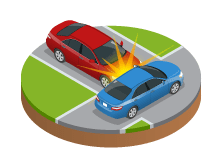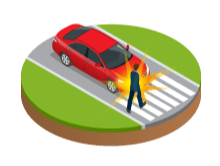Get the cheapest quotes for your car
Compare providers in your area.
Your information is secure
Compare providers in your area.
Your information is secure
Vermont drivers pay an average of $854.27 per year for car insurance according to the National Association of Insurance Commissioners (NAIC), that’s about $71.19 per month. Vermont drivers pay about 28% less than the countrywide national average of $1,189.64.
The NAIC takes into account all car insurance policies within the state such as drivers who select only state minimum coverage, as well as policies that include various levels of comprehensive and collision coverage. Because car insurance rates are influenced by personal factors, you could find yourself paying significantly less.

In at-fault states, the driver who caused the accident pays for damages.
Drivers in Vermont are required to carry a minimum amount of liability coverage to legally drive. You may see it written as 25/50/10, but we’ll break down what that means.

Vermont requires $25,000 in bodily injury liability per person and $50,000 of bodily injury per accident. That’s right in line with what most states require for this coverage.
This means $25,000 is the most your insurer will pay for a single person injured by you in an at-fault accident. And $50,000 is the maximum amount your insurer will pay if there is more than one person injured by you in an at-fault accident. Any costs outside of your bodily injury limit are required to come out of your pocket.

Massachusetts requires drivers to carry $10,000 of property damage liability to legally drive. This limit is on the lower end of requirements across the US for this coverage, though not uncommon.
This means $10,000 is the maximum amount your car insurance company will pay towards damages you cause to another person’s car or property, such as repairs to a car, fence or building. You’ll have to pay out of pocket for any costs beyond your property damage liability limit.

Vermont requires all drivers to carry $50,000 of uninsured motorist bodily injury per person, $100,000 uninsured motorist bodily injury per accident and $10,000 in uninsured motorist property damage to legally drive. Where most states require you to carry uninsured motorist coverage equal to your liability requirements, this state requires double your bodily injury liability limits in uninsured coverage.
This coverage protects you if you get hit by an uninsured or underinsured driver. It pays for your car’s damage or medical bills to you and your passengers.
These state-mandated requirements are the lowest amount of coverage you need to legally drive in Vermont, but may fall short if you’re in a major accident. To avoid high out-of-pocket costs after an accident, consider raising your liability limits by balancing coverage, your budget and what you can afford to pay out of pocket for certain damage.
Young drivers under age 35 might find the best deal with Geico. However, Progressive may offer the lowest price to drivers age 35 and over.
| Age | Progressive | Geico |
|---|---|---|
| 16-24 | $139.11 | $133.97 |
| 25-34 | $110.42 | $94.28 |
| 35-44 | $88.04 | $92.70 |
| 45-54 | $97.04 | $98.76 |
You can pay different rates with different companies based on your gender — often around $15 per month in Vermont. Based on this sample, men may want a quote from Progressive, while women may want to look into Geico.
| Company | Progressive | Geico |
|---|---|---|
| Men | $88.67 | $106.15 |
| Women | $113.93 | $91.15 |
In Vermont, Geico offers solid value based on car insurance cost information from Savvy.
| Company | Progressive | Geico |
|---|---|---|
| Rate | $105.51 | $98.65 |
The best car insurance companies in Vermont balance competitive prices in Vermont along with a variety of standard and add-on coverages. To cut through the noise, we vetted companies for you to bring our top recommendations for your area.
We looked at each company’s coverage, discounts and perks like its online experience and local agents. We also checked company ratings from J.D. Power, Better Business Bureau, AM Best and the National Association of Insurance Commissioners.
Geico
Finder score
Love savvy self-service tools? You can use Geico's handy app to manage your policy, sign forms, access your insurance card and file photo claims.
| Telematics | DriveEasy |
|---|---|
| Gap insurance | No |
| Telematics | DriveEasy |
|---|---|
| Gap insurance | No |
Amica
Finder score
| Telematics | StreetSmart |
|---|---|
| Gap insurance | Yes |
| Telematics | StreetSmart |
|---|---|
| Gap insurance | Yes |
Nationwide
Finder score
According to Nationwide, this policy could save you around $40 per month, or $480 per year, over a traditional policy. On top of saving money, you get a company with longstanding experience in the industry that's backed by strong finances.
| Telematics | Yes |
|---|---|
| Gap insurance | Yes |
| Telematics | Yes |
|---|---|
| Gap insurance | Yes |
Factors are characteristics specific to you that car insurance companies use to set how much you’ll pay for car insurance. The less risky each of your factors is, the less you pay. And the riskier you are, the more you’ll pay. We’ll break down Vermont’s rating factors to keep in mind.
| Factor | How it affects your rates |
|---|---|
Age | How old you are is a top factor in determining your car insurance rates. With each passing year, you earn more experience on the road. More experience can equal cheaper rates. Teen drivers pay the most, but rates begin to level off around your 20s with drivers over 50 paying the least. |
Gender | Vermont takes gender into account when determining your rates. On average, men in Vermont pay more for car insurance than women. The average annual premium across all age categories for men is $1,027, nearly $20 more per year than women, who pay an average of $1,008. |
Location | Where you live affects your rates, including where you park your car. High theft rates, high traffic and a high number of uninsured drivers could mean higher rates. When it comes to vehicle theft, Vermont has the lowest average in the country. For every 100,000 inhabitants, approximately 42.4 vehicles were stolen, according to Statista. The national average across the US is 246 cars for every 100,000 inhabitants. As for uninsured drivers, 8.8% of Vermonters on the road are uninsured. That ranks the state 37th out of 50 states for uninsured drivers, according to Insurance Information Institute. |
Vehicle and mileage | Your car’s make, model and trim directly affect how much you’ll pay for car insurance. Things like its cost, safety ratings, the likelihood of theft and sportiness all help insurers determine its cost to insure. Safer and cheaper vehicles score the lowest rates, with luxury vehicles with higher repair costs resulting in higher premiums. And, the more you’re on the road, the more at-risk you are to get in an accident, which means higher premiums. According to the Bureau of Transportation, Vermonters drive around 30.5 miles per day, which is under the national average of 36.1 miles per day. |
Credit score | Your credit score is included in your credit-based insurance score which insurers use to help calculate rates. According to the Insurance Information Institute, there is a strong correlation between your insurance score and claims filings. A good credit-based insurance score could mean lower rates. Vermont insurers charge the highest coverage rates for drivers with poor credit histories. Drivers with good credit scores could see an annual insurance rate of about $1,063. These rates rise to about $1,280 with a fair credit score and approximately $1,861 for those with poor credit. |
Coverage | The more coverage you get and the higher limits you choose, the more protection you’ll have and the more you’ll pay in monthly premiums. If you opt for full coverage car insurance that includes comprehensive and collision, the amount of your deductible weighs into your costs too. Higher deductibles mean lower monthly premiums. Low coverage costs in Vermont average to about $869 yearly, whereas high coverage can be anywhere around $1,077 on average. |
Driving Record | The better your record, the lower your premium. If you’re in an at-fault accident you could see rates increases from 20% to 50%. A DUI in Vermont can increase your rate by an average of 73%. These types of violations typically stay on your record for about five years. Vermont drivers with a clean driving record pay approximately $1,063 annually — or $139 less per year on average — than Vermont drivers with one speeding violation. |
You’ll need to file an SR-22 with the Vermont DMV for at least three years from the violation. An SR-22 is a proof of insurance form, showing that you can take financial responsibility for any accidents you cause. In Vermont, you’re required to file an SR-22 after major violations that lead to a suspended license, like a DUI or driving without insurance.
Driving across the mountains and open plains in Vermont means taking on different driving conditions and hazards on the road. While Vermont’s required insurance is a solid starting place for protection, think about these add-ons to cover all the possibilities.
When you get in a car accident, you can’t control the seriousness of the damage or injuries to other people. While Vermont’s liability limits should take care of minor damage, it may not protect you from major accidents, especially if someone takes you to court. Legal expenses and medical bills can easily total tens of thousands of dollars.
To make sure you have plenty of liability coverage, talk with your insurance agent about the amount of protection you need.
No matter where you drive, you have the chance of getting in an accident with another driver. If you’re considered the one at fault, you’ll need collision coverage if you want your insurance to pay for your car repairs.
Keep in mind that some accidents like rearend collisions can be deemed your fault even if you tried to stop them from happening. Collision coverage can bring you that extra peace of mind that you can take care of your car no matter the situation.
Consider this coverage if . . .
In Vermont, you navigate icy roads, snow and heavy rain throughout the year, along with other normal road hazards. If you wreck your car because of weather, you could pay for your repairs through comprehensive coverage. It kicks in for many damages outside of colliding with another car, including theft, damage from a falling tree branch or rock cracking your windshield. The optional coverage is worth considering because it protects against many different scenarios.
Consider this coverage if . . .
We’ve pulled the top 10 companies by market share that offer coverage in Vermont, according to S&P Global. Compare top companies by three major rating agencies along with our overall score.
| Provider | BBB Rating | JD Power Rating | NAIC complaint ratio | National market share % | Finder score | Go to site |
|---|---|---|---|---|---|---|
State Farm | A+ | 847/1000 | 1.93 | 16.2 | ★★★★★ 4/5 | |
Geico | A+ | 832/1000 | 1.42 | 13.6 | ★★★★★ 4/5 | |
Progressive | A+ | 830/1000 | 1.05 | 13.3 | ★★★★★ 4/5 | Get Quotes |
Allstate | A+ | 827/1000 | 2.71 | 10.4 | ★★★★★ 4/5 | |
USAA | A+ | 884/1000 | 1.9 | 6.3 | ★★★★★ 4/5 | |
Farmers | A- | 820/1000 | 1.64 | 4.9 | ★★★★★ 4/5 | |
Liberty Mutual | A+ | 827/1000 | 2.2 | 4.7 | ★★★★★ 4/5 ; | Get Quotes |
Nationwide | A+ | 814/1000 | 2.08 | 2.3 | ★★★★★ 4/5 | |
Travelers | A+ | 820/1000 | 3.28 | 2 | ★★★★★ 4/5 | |
Auto Club Exchange | A+ | NR | NR | 1.4 | ★★★★★ 4/5 |
Of Vermont’s largest cities, Rutland has the cheapest rates and Essex Junction has the most expensive car insurance rates. Essex Junction drivers could face rates 3 times more than Rutland drivers.
| Company | Annual car insurance rate |
|---|---|
| Allstate | $2834 |
| Progressive | $2008 |
| Liberty Mutual | $2093 |
| Geico | $998 |
| InsureMyTesla | $2093 |
| Company | Annual car insurance rate |
|---|---|
| Allstate | $2588 |
| Progressive | $2032 |
| Liberty Mutual | $2342 |
| Geico | $957 |
| InsureMyTesla | $2342 |
| Company | Annual car insurance rate |
|---|---|
| Allstate | $2578 |
| Progressive | $2042 |
| Liberty Mutual | $2093 |
| Geico | $998 |
| InsureMyTesla | $2093 |
| Company | Annual car insurance rate |
|---|---|
| Allstate | $2578 |
| Progressive | $1995 |
| Liberty Mutual | $2093 |
| Geico | $998 |
| InsureMyTesla | $2093 |
| Company | Annual car insurance rate |
|---|---|
| Allstate | $2578 |
| Progressive | $1995 |
| Liberty Mutual | $2097 |
| Geico | $1000 |
| InsureMyTesla | $2097 |
Vermont is an at-fault state, which means that the driver who caused the car accident pays for the damage. Your insurance company and legal authorities will figure out who’s at fault, based on the accident details.
However, Vermont also looks at whether both drivers are partially at fault under a modified comparative fault law, according to the legal website Nolo. Under this law, both drivers are assigned a percentage of fault. Drivers who are less than 50% at fault can get paid for damage caused by other drivers.
For example, if you’re 80% responsible for an accident, your insurance will pay 80% of the other driver’s damages. However, since you’re over 50% at fault, the other driver isn’t required to pay for your damages.
Car insurance helps to protect you, your vehicle and everyone else on the road, and it’s legally required to get behind the wheel in the scenic state of Vermont. Vermont’s auto insurance rates are relatively low compared to national averages, but you could find ways to save even more if you’re willing to shop around and compare offerings from multiple providers.
To learn more about insurance regulations, discounts, policy extras and more, read our comprehensive guide to car insurance.
A review of CashUSA, a loan connection service that may match you with lenders offering loans up to $10,000.
Explore different ways you could earn money playing games with GPT apps, Twitch streaming, esports competitions, and trading cards.
Compare highly rated and legit survey sites for your next side hustle, how to maximize your survey earnings, and how to avoid scams.
Learn how to become user tester, how much you can earn, top platforms for user testing, and how to avoid scams.
Learn how to earn money through trusted online surveys, including top platforms, practical tips, and some red flags to watch out for.
Earning extra cash can be as simple as sharing your thoughts. In this guide, we’ll walk you through some of the most trusted survey sites and show you how to get started right away.
Cash Advance loans by amount from $100 all the way up to $1,000 USD.
Bonds, treasury securities, blue chip stocks, ETFs, REITs, CDs and annuities are some of the best investments for retirees.
GoHenry is now Acorns Early. If you’re looking for a GoHenry alternative, try Greenlight, Step, Current, Modak Makers or Chase First.
Top apps like Self that build credit include Kikoff, Grow Credit, Chime Secured Credit Builder Card, Credit Strong and Cleo.